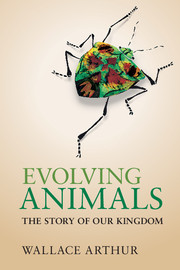Book contents
- Frontmatter
- Dedication
- Contents
- Preface
- Acknowledgements
- 1 What is an animal?
- 2 Before there were animals
- 3 How to make a fossil
- 4 The Cambrian explosion
- 5 How to make a species
- 6 Jellyfish and their kin
- 7 How to make a tree
- 8 The enigmatic urbilaterian
- 9 Animal symmetry and heads
- 10 A plethora of worms
- 11 Trends in animal complexity
- 12 Where the octopus is king
- 13 How to make an animal
- 14 Exoskeletons galore
- 15 Extinction
- 16 Mouth first, mouth second
- 17 Comparing embryos
- 18 Larvae, mouthparts and moulting
- 19 The animal toolkit
- 20 Vertebrate origins and evolution
- 21 From water to land to water
- 22 Variation and inheritance
- 23 Evolutionary novelties
- 24 Human origins and evolution
- 25 Animal plasticity
- 26 The nature of adaptation
- 27 The direction of evolution
- 28 Animal extremophiles
- 29 Extraterrestrial animals?
- 30 The ghost in the machine
- Appendix
- References
- Index
23 - Evolutionary novelties
Published online by Cambridge University Press: 05 August 2014
- Frontmatter
- Dedication
- Contents
- Preface
- Acknowledgements
- 1 What is an animal?
- 2 Before there were animals
- 3 How to make a fossil
- 4 The Cambrian explosion
- 5 How to make a species
- 6 Jellyfish and their kin
- 7 How to make a tree
- 8 The enigmatic urbilaterian
- 9 Animal symmetry and heads
- 10 A plethora of worms
- 11 Trends in animal complexity
- 12 Where the octopus is king
- 13 How to make an animal
- 14 Exoskeletons galore
- 15 Extinction
- 16 Mouth first, mouth second
- 17 Comparing embryos
- 18 Larvae, mouthparts and moulting
- 19 The animal toolkit
- 20 Vertebrate origins and evolution
- 21 From water to land to water
- 22 Variation and inheritance
- 23 Evolutionary novelties
- 24 Human origins and evolution
- 25 Animal plasticity
- 26 The nature of adaptation
- 27 The direction of evolution
- 28 Animal extremophiles
- 29 Extraterrestrial animals?
- 30 The ghost in the machine
- Appendix
- References
- Index
Summary
Evolutionary novelties represent a topic of immense current interest, and yet they are notoriously hard to define. It’s probably best to explain what they are by giving examples, and contrasting these with examples of what can be called routine evolutionary change.
In fact, we have already come across two examples of evolutionary novelties at the level of the cell. These were the stinging cells of jellyfish and their allies and the neural crest cells that are found in the vertebrates. In both cases, the cell-type involved is not found anywhere outside of the group concerned (respectively, the Cnidaria and the Vertebrata). Thus stinging cells must have arisen in the cnidarian stem lineage and neural crest cells in the stem lineage of the vertebrates.
Of course, nothing in evolution arises de novo: everything evolves from something else. So in one sense nothing is ever truly new. But in another, important, sense some things come much closer to being new than others. To try to illustrate this point, let’s turn from the level of the cell to the level of large parts of the structure of animals. We’ll look at two examples of novelties at this level, one in an arthropod, the other in a vertebrate: the venom claws of centipedes and the protective shell of turtles. But before getting into the details of these examples, it makes sense to discuss the non-novel or routine end of the spectrum of evolutionary changes.
- Type
- Chapter
- Information
- Evolving AnimalsThe Story of our Kingdom, pp. 232 - 240Publisher: Cambridge University PressPrint publication year: 2014



